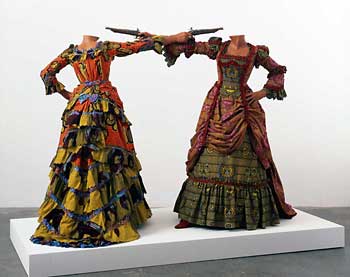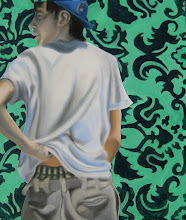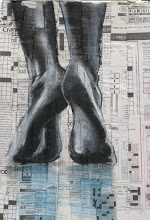Tuesday, December 08, 2009
Art 1 Final Study Guide
Color Terms:
1. Tint
2. Shade
3. Value
4. Hue
5. Cool colors
6. Warm colors
7. Analogous colors
8. Color wheel (colors in correct order)
9. Monochromatic color scheme
10. Complimentary colors
11. Primary colors
12. Secondary colors
13. Under painting
Drawing and design terms:
1. Contour line drawing – 4 types of contours
2. Negative space
3. Texture
4. Enlarging with a grid
5. Highlights
6. Shading – 4 types of shading
Principles of Design:
1. Harmony
2. Proportion
3. Asymmetrical balance
4. Symmetrical balance
5. Cropping
6. Deconstruct
7. Emphasis
8. Rhythm
9. Variety
Elements of Art:
1. Line
2. Color
3. Shape
4. Value
5. Texture
6. Form
7. Space
Sunday, November 15, 2009
APAH Slide List Quiz 11/20/09
1. The Good Shepherd, Catacomb of Sts. Peter & Marcellinus, Rome, 4th century
2. Christ seated, Civita Latina, Italy, 350-375 CE
3. Old Saint Peter’s, Rome, Italy 320
4. Santa Costanza, Rome, Italy, 337-351
5. Vault mosaic in ambulatory, Santa Costanza, Rome, Italy, 337-351
6. The Parting of Lot and Abraham, mosaic, Santa Maria Maggiore, Rome, Italy,
432-440
7. Mausoleum of Galla Placidia, Ravenna, Italy, 425
8. Christ as the Good Shepherd, mosaic, Galla Placidia, Ravenna, Italy, 425
9. Interior of Saint’Apollinare Nuovo, Ravenna, Italy, 504
10. Suicide of Judas/Crucifixion of Christ, ivory box, 420
Monday, October 19, 2009
Saturday, October 17, 2009
AP Studio Sketchbook 2009-10
Here’s the new list:
Ballpoint pen
Contradiction
Jim Dine tools
Dirty Water drawing with Sharpie (weighted line)
5 drawings on top of each other
Exaggeration
Mechanics of an Object
Less than an Inch
Art History Revealed
I hate these things!
Drawing with Colored Paper
Lonely……..Object
Random Acts of Art
Mundane
Manmade vs. Nature
Masking Tape patterns and Colors
A word and Visual Description
Free Space
All that and the Kitchen Sink
Loquacious
Messiest vs. Cleanest
Dot Drawing (only a pencil eraser and ink)
Object I found at this location (collage design only)
APAH Greek Architecture Quiz for Haleigh
2. In relief sculpture, the term used when all heads are kept at the same level to preserve unity of design: _________________________
3. An architectural term for a round temple is: __________________
4. The names for the “end” spaces of a Greek temple: ________________and_________________________
5. The name of the patron in charge of the Parthenon’s architectural programs:________________
6. In a Greek temple, the architectural term used to describe the outward swelling of the column shafts as they rise and then taper: ______________________________________
7. Complete the following regarding the buildings on the Acropolis constructed during the Classical period:
Name of Building Date/Order Function
________________________________________________________________________________________________________________________________________________________________________________________________________________________________________________________________________________________________________________________
8. List the four sculpture programs of the Parthenon and their subject matter:
________________________________________________________________________________________________________________________________________________________________________________________________________________________________________________________________________________________________________________________
9. The name of the most Hellenistic architectural and sculptural (combination) monument: ______________________________. Its patron: ______________________________________
10. Label the parts of this Greek temple:
a. _________________________
b. _________________________
c. _________________________
d. _________________________
e. ______________________________________
Monday, October 12, 2009
APAH Quiz 7
1. In a Greek temple, the architectural term used to describe the outward swelling of the column shafts as they rise and then taper: ______________________________________
2. The sculpted maidens that replace a column: _____________________________
3. In relief sculpture, the term used when all heads are kept at the same level to preserve unity of design: ____________________________________________________
4. An architectural term for a temple surrounded on all sides with columns: __________________
5. The names (both of them!) for the largest interior space of a Greek temple: ________________ or _________________________
6. The name of the sculptor in charge of the Parthenon’s sculpture programs: ________________
7. Complete the following regarding the buildings on the Acropolis constructed under the leadership of Pericles:
Name of Building Date/Order Function
________________________________________________________________________________________________________________________________________________________________________________________________________________________________________________________________________________________________________________________
8. List the four sculpture programs of the Parthenon and their subject matter:
________________________________________________________________________________________________________________________________________________________________________________________________________________________________________________________________________________________________________________________
9. The name of the most Hellenistic architectural monument: ______________________________
Its patron: _______________________________________
10. Label the parts of a Greek temple: (image to be provided!)
a. _________________________
b. _________________________
c. _________________________
d. _________________________
e. _________________________
f. _________________________
g. _________________________
h. _________________________
i. _________________________
Thursday, October 08, 2009
Thursday, September 10, 2009
(Psssst! Answers to the Friday Quiz below!)
1. silhouette
2. undulating
3. shaman
4. abstraction, schematic
5. mimetic
6. no written language, no context to base observations on
7. additive, subtractive
8. Leonard Woolley
9. post and lintel
10. temple, tomb, votive with interior, block statue, sarcaphogi, mastabe, urn (with organs)
11. physical, artist/patron, historical, concepts/ideas
apparently there is no 12!
13. What is determined by context. The intended purpose of a thing.
14. To show movement, conceptual rather than optical
15. Afterlife will be rewarded (votives and offerings), gods live in "heaven" (temples on top of mastabas)
Sunday, September 06, 2009
APAH Quiz Week 3
Kuntz
Vocabulary/Ideas and Concepts/Facts/Art and Architecture Terms
Clearly print or write your answers on the lines provided:
1. What is “The outline of a figure/form viewed as circumscribing a mass” called: ______________
2. The word often used to describe a surface that curves in and out: _________________________
3. A religious person thought to have special powers of healing or seeing the future: ____________
4. The simplest, most direct presentation of an image (often just using line): __________________ or _______________________.
5. The Greek word for the idea that earliest “art” was just copying nature: ____________________
6. Why is the function and context of Prehistoric art unknown?: ____________________________
7. The two basic methods of making sculpture are _________________or ____________________
8. Who discovered the Royal Cemetery of Ur? ___________________________________________
9. The method of construction used in Stonehenge ___________________and ________________
10. What is sacred space in ancient cultures? ____________________________________________________________________________________________________________________________________________________________
11. What are the 4 ways of thinking of context?
12. ________________ 2._________________ 3. _________________ 4.___________________
13. What is function? _______________________________________________________________
14. Why was twisted perspective (two points of view in the representation of a single figure) used? ____________________________________________________________________________________________________________________________________________________________
15. What was the Sumerian view of “afterlife” and name an example. Be specific. ______________________________________________________________________________
Saturday, August 01, 2009
APAH Calendar 2009-10
August 2009 | ||||||
Sunday | Monday | Tuesday | Wednesday | Thursday | Friday | Saturday |
Notes: | 1 | |||||
2 | 3 | 4 | 5 | 6 | 7 | 8 |
9 | 10 | 11 | 12 | 13 | 14 | 15 |
16 | 17 | 18 | 19 | 20 | 21 | 22 |
23 | 24 Summer Work Due Overview PP Week 1 handouts Slide List 1 | 25 What is Art? How this class works - Formats | 26 Prehistoric What is Context? | 27 Sumerian | 28 Quiz 1 – Prehistoric Homework 1 | 29 |
30 | 31 Sumerian How to Analyze Sculpture | Notes: Check out the APAH Site at www.kuntzarts.blogspot.com/ For extra credit and tidbits that will make you a trivia aficionado! | ||||
September 2009 | ||||||
Sunday | Monday | Tuesday | Wednesday | Thursday | Friday | Saturday |
Notes: | 1 Sumerian Function & Context | 2 Acadian Neo-Sumerian Babylonian Hittite | 3 Acadian Neo-Sumerian Babylonian Hittite | 4 Quiz 2 – Sumerian Hmk 2 | 5 | |
6 | 7 No School | 8 Old & New Kingdom Egyptian Conventions & Canons | 9 Old & New Kingdom Egyptian Conventions & Canons | 10 Old Kingdom Egyptian Architecture (terminology) | 11 Quiz 3 – Acadian, Neo-Sumerian Hmk 3 | 12 |
13 | 14 New Kingdom Egyptian Architecture (terminology) | 15 Egyptian Painting Amarna, What is this style? | 16 | 17 Review/Catch Up | 18 Unit Test #1 Prehistoric – Egyptian
Hmk 4 | 19 |
20 | 21 Proto-Greek Cycladic, Minoan, Mycenaean Context | 22 Abstraction What is Appropriation? Elements of Design | 23 Greek Context & Sculpture | 24 Greek Context & Sculpture | 25 Quiz 4 – Proto-Greek Hmk 5 | 26 |
27 | 28 Greek Sculpture | 29 Greek Architecture | 30 Greek Architecture | Notes: | ||
October 2009 | ||||||
Sunday | Monday | Tuesday | Wednesday | Thursday | Friday | Saturday |
Notes: | 1 Greek Architecture | 2 Quiz 5 – Greek Sculpture & Architecture Hmk 6 | 3 | |||
4 | 5 Greek Painting Black & Red Vase Painting | 6 Greek Painting | 7 Etruscan (Roman Context) | 8 Etruscan | 9 Quiz 6 – Greek Painting & Etruscan Hmk 7 | 10 |
11 | 12 Roman Republic Architecture & Temples Appropriation & Propaganda | 13 Roman Republic | 14 Roman Imperial Roman building technologies | 15 Roman Sculpture | 16 Quiz 7 – Roman Architecture & Sculpture Hmk 8 | 17 |
18 | 19 Staff Development
| 20 Roman Sculpture | 21 Roman Wall Painting – fresco, illusionism & creating space in painting | 22 Roman Painting | 23 Unit Test #2 – Proto-Greek to Roman Hmk 9 | 24 |
25 | 26 Early Christian Context Sculpture Painting | 27 Early Christian | 28 Early Christian | 29 | 30 Quiz 8 – Early Christian Hmk 10 | 31 |
November 2009 | ||||||
Sunday | Monday | Tuesday | Wednesday | Thursday | Friday | Saturday |
1 | 2 Byzantine Architecture & Mosaics | 2 Byzantine | 4 Migratory Art Viking Hiberno-Saxon | 5 Migratory Art Carolingian | 6 Quiz 9 – Byzantine & Migratory Hmk 11 | 7 |
8 | 9 Staff Development | 10 Carolingian & Ottonian | 11 Romanesque Context Architecture | 12 Romanesque Architecture | 13 Quiz 10 – Carolingian/ Ottonian/ Romanesque Hmk 12 | 14 |
15 | 16 | 17 | 18 | 19 | 20 | 21 |
22 | 23 | 24 | 25 Thanksgiving | 26 Thanksgiving | 27 Thanksgiving | 28 |
29 | 30 | Notes: | ||||
December 2009 | ||||||
Sunday | Monday | Tuesday | Wednesday | Thursday | Friday | Saturday |
Notes: | 1 | 2 | 3 | 4 | 5 | |
6 | 7 | 8 | 9 | 10 | 11 | 12 |
13 | 14 | 15 | 16 | 17 | 18 Plan & Prep No Students | 19 |
20 | 21 Christmas Break | 22 Christmas Break | 23 Christmas Break | 24 Christmas Break | 25 Christmas Break | 26 |
27 | 28 Christmas Break | 29 Christmas Break | 30 Christmas Break | 31 Christmas Break | Notes: | |
January 2010 | ||||||
Sunday | Monday | Tuesday | Wednesday | Thursday | Friday | Saturday |
Notes: | 1 Christmas Break | 2 | ||||
3 | 4 Staff Development | 5 | 6 | 7 | 8 | 9 |
10 | 11 | 12 | 13 | 14 | 15 | 16 |
17 | 18 No School | 19 | 20 | 21 | 22 | 23 |
24 | 25 | 26 | 27 | 28 | 29 | 30 |
31 | Notes: | |||||
February 2010 | ||||||
Sunday | Monday | Tuesday | Wednesday | Thursday | Friday | Saturday |
Notes: | 1 | 2 | 3 | 4 | 5 | 6 |
7 | 8 | 9 | 10 | 11 | 12 Staff Development | 13 |
14 | 15 Staff Development | 16 | 17 | 18 | 19 | 20 |
21 | 22 | 23 | 24 | 25 | 26 | 27 |
28 | Notes: | |||||
March 2010 | ||||||
Sunday | Monday | Tuesday | Wednesday | Thursday | Friday | Saturday |
Notes: | 1 | 2 | 3 | 4 | 5 | 6 |
7 | 8 | 9 | 10 | 11 | 12 | 13 |
14 | 15 Spring Break Italy/Greece 2010! | 16 Spring Break Italy/Greece 2010! | 17 Spring Break Italy/Greece 2010! | 18 Spring Break Italy/Greece 2010! | 19 Spring Break Italy/Greece 2010! | 20 |
21 | 22 | 23 | 24 | 25 | 26 | 27 |
28 | 29 | 30 | 31 | Notes: | ||
April 2010 | ||||||
Sunday | Monday | Tuesday | Wednesday | Thursday | Friday | Saturday |
Notes: | 1 | 2 No School | 3 | |||
4 | 5 | 6 | 7 | 8 | 9 | 10 |
11 | 12 | 13 | 14 | 15 | 16 | 17 |
18 | 19 | 20 | 21 | 22 | 23 | 24 |
25 | 26 | 27 | 28 | 29 | 30 | Notes: |
May 2010 | ||||||
Sunday | Monday | Tuesday | Wednesday | Thursday | Friday | Saturday |
Notes: | 1 | |||||
2 | 3 | 4 | 5 | 6 | 7 | 8 |
9 | 10 | 11 | 12 | 13 | 14 | 15 |
16 | 17 | 18 | 19 | 20 | 21 | 22 |
23 | 24 | 25 | 26 | 27 | 28 | 29 |
30 | 31 No School | Notes: | ||||
June 2010 | ||||||
Sunday | Monday | Tuesday | Wednesday | Thursday | Friday | Saturday |
Notes: | 1 | 2 | 3 | 4 | 5 | |
6 | 7 | 8 | 9 | 10 | 11 | 12 |
13 | 14 | 15 | 16 | 17 | 18 | 19 |
20 | 21 | 22 | 23 | 24 | 25 | 26 |
27 | 28 | 29 | 30 | Notes: | ||
July 2010 | ||||||
Sunday | Monday | Tuesday | Wednesday | Thursday | Friday | Saturday |
Notes: | 1 | 2 | 3 | |||
4 | 5 | 6 | 7 | 8 | 9 | 10 |
11 | 12 | 13 | 14 | 15 | 16 | 17 |
18 | 19 | 20 | 21 | 22 | 23 | 24 |
25 | 26 | 27 | 28 | 29 | 30 | 31 |
August 2010 | ||||||
Sunday | Monday | Tuesday | Wednesday | Thursday | Friday | Saturday |
1 | 2 | 3 | 4 | 5 | 6 | 7 |
8 | 9 | 10 | 11 | 12 | 13 | 14 |
15 | 16 | 17 | 18 | 19 | 20 | 21 |
22 | 23 | 24 | 25 | 26 | 27 | 28 |
29 | 30 | 31 | Notes: | |||






